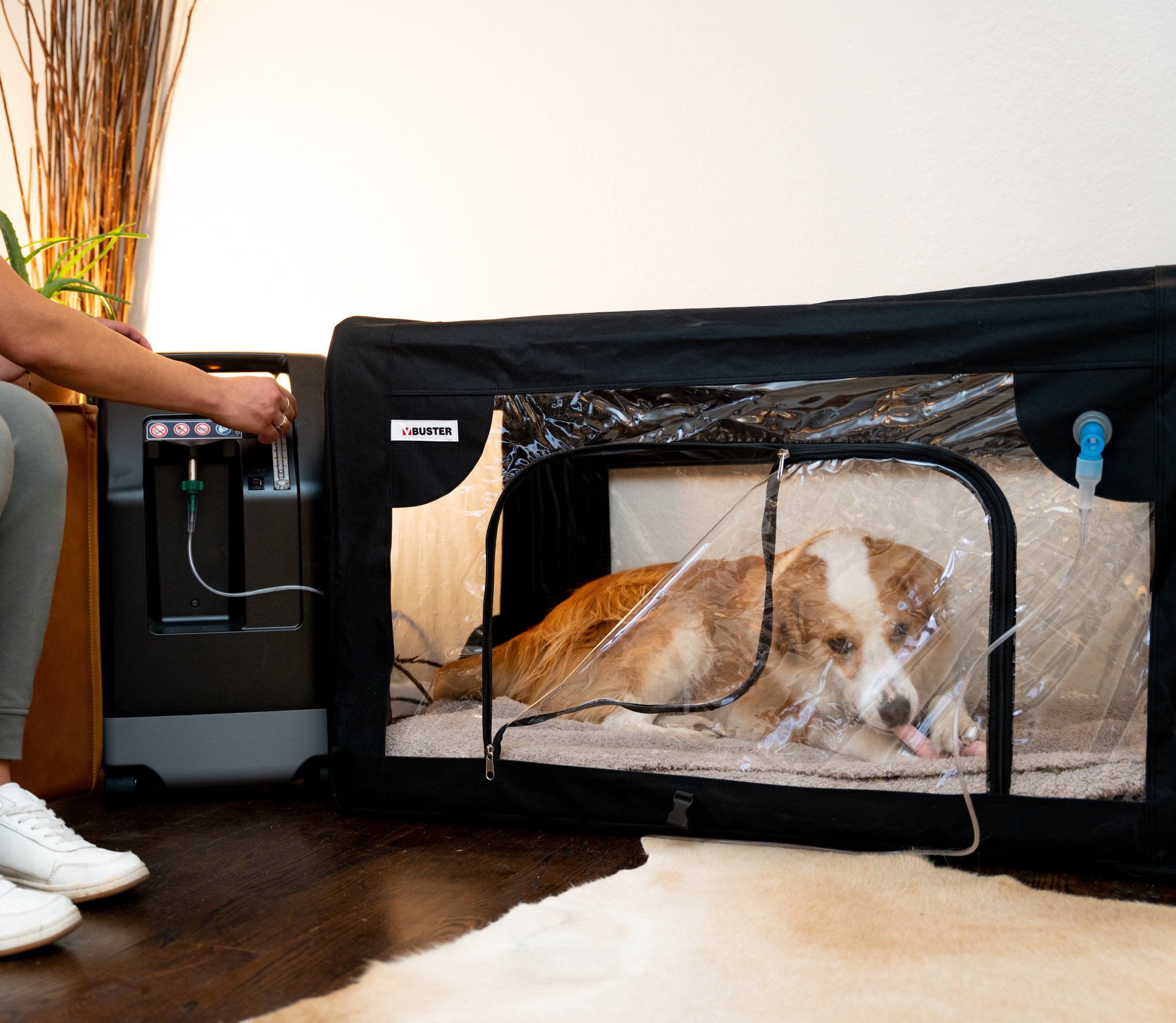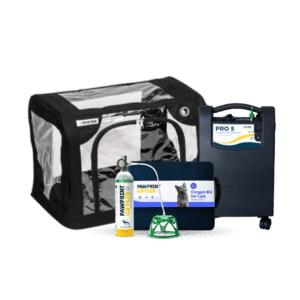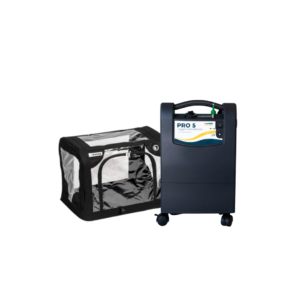Just like us, our pets can suffer from respiratory illnesses and conditions that require oxygen therapy. When choosing your pet’s oxygen products, it is vital that you choose medical-grade, quality equipment to ensure they are provided with proper medical care.
Many pets that require oxygen may have worsening symptoms when excited. Excited barking, stress, and an increased level of exercise exacerbate many heart and lung conditions, leading to a higher risk for a medical emergency.
Having a Portable Oxygen Kit on-hand enables you to provide oxygen therapy at home to calm your pet, reducing stress and keeping your pet out of the ER. In case of a true emergency, the portable kit can be used during transport to administer life-saving oxygen therapy on the way, giving your pet a better chance of arriving to the ER in time for emergency care.
With a medical-grade oxygen concentrator and Buster ICU oxygen cage, you can administer oxygen for longer periods of time for pets that require oxygen therapeutically for treatment of life-long illnesses. This equipment can also be used short-term for recovery of certain illnesses, like pneumonia, or for recovery from surgery or injury. Having an oxygen concentrator and cage on-hand at home keeps pets from being hospitalized for an extended period, which reduces costs for pet parents and stress for your pet.
The Risks of Low-Quality Oxygen Products
Having high-quality medical-grade equipment is essential to ensuring your pet is receiving proper medical care. Unfortunately for pet parents, there are many products on the market that will not produce a safe level of oxygen for your pet.
Labeled as non-medical grade oxygen or recreational oxygen, these products provide a low saturation of oxygen, which is not adequate to treat heart and lung conditions. Non-medical oxygen canisters, typically labeled for recreational use for humans, do not have an adequate dosing system so it is unclear how much oxygen, if any, your pet is getting.

Non-medical grade concentrators do not produce safe levels of oxygen
Typically, pets require a minimum flow rate of 5 Liters per minute to safely fill a small oxygen chamber, and the high quality medical-grade units produce 90% oxygen saturation at 5 Liters.
Low quality, non-medical grade units may produce 90% oxygen at 1 Liter per minute, but as you increase the flow rate, the saturation of oxygen goes down, sometimes as low as 25%, which is barely more than you breathe in room air; this is not a safe level to fill an oxygen chamber.
Many of the non-medical grade oxygen chambers sold with these low-quality concentrators are also not set up to adequately vent CO2, heat, and humidity, and combined with the low saturation of oxygen, can lead to a very unsafe environment for your pet.
Understanding Pet Respiratory Conditions
There are many conditions that require treatment with medical-grade oxygen therapy in pets. Some common conditions are:
- Feline Asthma
- Bronchitis
- Pneumonia
- Pulmonary Hypertension
- Congestive Heart Failure
- Collapsing Trachea
- Laryngeal Paralysis
Bronchitis, Feline Asthma, Pulmonary Hypertension, and Pneumonia, while very different conditions, have similarities in that these conditions constrict or block the lungs’ abilities to process oxygen. Lacking oxygen, the cells of the body become starved, creating a very dangerous situation for pets. Antibiotics, diuretics, and bronchodilators are often prescribed to pets with these conditions, and prescribing oxygen along with these treatments can be very effective. Having oxygen on hand to administer while the lungs clear can be instrumental in keeping your pet comfortable.
Congestive Heart Failure is a very common condition in older pets, and can lead to decompensation, a condition where the pet’s blood oxygen levels drop very quickly due to the heart’s inability to keep up with the needs of the body. Having oxygen in hand keeps your pet comfortable while emergency care is sought.
Collapsing Trachea and Laryngeal Paralysis are both very common conditions, and both benefit from oxygen therapy. The trachea and larynx can become inflamed or damaged, creating a blockage in the pet’s airway. Administering oxygen can give these pets much needed oxygen so that further care or medications can be safely provided.
1. Oxygen Chamber
Our Oxygen Chambers are cost effective, mobile (not built into a wall) and durable. Pet Owners can set these up with ease in their own home and administer multiple times a day.
The problems with these non-medical grade Oxygen products
The above conditions require medical- grade oxygen, and the risk of providing your pet with therapy with a low-quality oxygen product can be detrimental to their health. Here are the major problems with these non-medical grade products:
- Not able to reach a high enough saturation of oxygen.
- Not able to reach a high enough flow rate.
- Unsafe build-up of CO2, heat, and humidity.
- Inability to vent properly.
- Not able to set the percentage of saturation to match pet’s condition and needs.
Additionally, many of the companies that sell non-medical grade equipment have misleading information in their product descriptions. For example, they often advertise that their concentrators can reach 90% oxygen saturation but will withhold information that this is only at very low flow rates. Additionally, the unsafe conditions created by the non-medical oxygen concentrators and cages may cause your pet to go into crisis, since they are not receiving adequate oxygen. If the pet is left in the cage too long without a high enough saturation of oxygen and a low flow rate, CO2 will build up and cause CO toxicity, which is very dangerous, and can lead to death if not remedied.
How to Choose the Right Oxygen Product for Your Pet
In contrast, the medical-grade products we provide are prescribed by your veterinarian, ensuring you are getting the equipment that will help your pet best. The Buster ICU Oxygen Cage used with our medical-grade concentrators can replicate the same conditions pets are in when they receive oxygen therapy at the veterinary office. The Buster ICU Oxygen Cage uses the Venturi system that allows pet parents to select the oxygen concentration inside the oxygen cage. This allows for more control, as some conditions require specific concentrations of oxygen for treatment. For example, pets with heart conditions like Congestive Heart Failure typically require 60% oxygen saturation, which means that the air inside the oxygen cage will be 60% pure oxygen and 40% room air. With the different Venturi adapters, pet owners can set the oxygen concentration to exactly what the veterinarian prescribes.
The Portable Oxygen Canisters provide 99% pure oxygen in emergencies for use at home or during transport. With a selection of four pre-set flow rates that are prescribed based on your pet’s weight, medical history, and condition, you can ensure you are giving your pet the correct amount of oxygen. The specially designed PureVent Pet Oxygen Mask provides an oxygen saturation of 62%, which is ideal for emergency use.
Love this company
Pet owner Adda Wong explains her experience with the Pro5 Oxygen Concentrator and Buster ICU Oxygen Cage, “My baby was diagnosed with a collapsed trachea and the vets basically told us that she was on borrowed time. After doing my research and pushing the ER vet to write me a prescription, I’m so glad we purchased the oxygen kit. After being released from the hospital, we’ve been putting our baby in the oxygen cage for 15 mins morning/night *consult with your vet on timing*. It’s been a few weeks and we’ve seen significant improvements. Highly recommend it!!”
Oxygen helped so much!
Mark Wiley has used our Portable Oxygen Kit for his lab Beaux diagnosed with laryngeal paralysis, and advises, “Our Lab has a loose flap which makes it hard to breathe especially when he gets excited. I reached out to Pawprint, and they got the process started. They made a quick call to the vet’s office and within a few days we had the oxygen. The kit is simple and when Beaux needs it, we have additional oxygen at the ready. Our dog was scared at first but once he saw it made him feel better, he relaxed and took deep breaths. Thanks, Pawprint.”
By working with your veterinarian, Pawprint Oxygen can assist you with any questions you may have about your equipment and how to administer the oxygen to your pet. With over 6,000 pets helped, and over 5,000 veterinary offices utilizing our services across the US, our team members have the knowledge and experience to answer your questions, and having medical-grade oxygen equipment for your pet is the best way to ensure you are doing everything you can to keep them comfortable and thriving while on oxygen therapy.
The Pet Oxygen Shop
-
Sale!

Extended Oxygen Therapy Bundle for Pets, up to 25 lbs
$1,300.00 -
Sale!

Extended Oxygen Therapy Bundle for Large Pets, up to 70 lbs
$2,100.00 -
Sale!

Extended + Rescue Oxygen Therapy Bundle for Large Dogs
$2,300.00 -
Sale!

Extended + Rescue Oxygen Therapy Bundle for Cats
$1,500.00 -
Sale!

Extended + Rescue Oxygen Therapy Bundle for Small Dogs
$1,500.00 -
Sale!

Extended Oxygen Therapy Bundle for Pets, up to 10 lbs
$1,200.00

